► Tamiya GF-02 Squash Van tried and tested
► 1950’s Ford panel van styling
► Immense off-road capabilities in 1/10th scale
I’m always a little bit excited when Tamiya bring out a new chassis, and the Tamiya GF-02 Squash Van does not disappoint. While most manufacturers have similar layouts, you never know what kind of weird and wonderful creation you’ll get from Shizuoka.
It’s a 1/10th scale four-wheel drive monster truck with four-wheel independent suspension and the option of four-wheel steering. Tamiya even gives you all the hardware in the box to make it happen, you just need an extra servo and radio gear that’ll allow you to control it.
Look past the fantastically detailed 50’s panel van body and things get weirder. Instead of belt or shaft drive, a myriad gears transfer power from the central motor to the differentials. As the chassis is stuffed full of cogs, the battery goes on top along with the electronics.
It’s not the first time Tamiya has used this layout. Both the GF-01 wheelie truck and G6-01 six-wheel drive use shorter and longer versions of the chassis respectively. The GF-02 sits neatly in the middle by offering more driveability than the GF-01 and more manoeuvrability than the G6-01.
The Squash Van comes as a kit you’ll need to put together yourself. Tamiya includes an electronic speed controller and standard silver can motor, along with a box wrench and Allen key. You’ll need a transmitter and receiver, a servo, battery and charger to make it all work, and two tins of spray paint to get the two-tone look.
A long-time Tamiya collector, keen RC driver and experienced road tester, CAR Magazine’s New Cars Editor, Alan Taylor-Jones will be testing the Tamiya Squash Van. Keep reading to see what he thinks of the build process and driving experience.
Tamiya GF-02 Squash Van
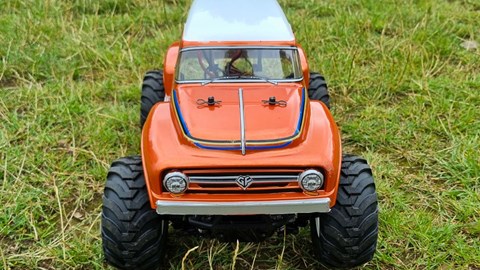
Pros:
Cons:
- Rivals have a higher standard specification
- Motor can get exceedingly hot
Features:
- Motor and speed controller included
- Radio, battery, charger and paint required
- Can be built with four-wheel steer out of the box
- Upgrades easily available
The build:
Even by Tamiya standards, the GF-02 is easy to put together. Plastic parts are clearly numbered on lettered sprues, hardware is in lettered bags, and all the stickers are numbered in a specific order. A bit of prep goes a long way. Read the manual before you start, get a few trays for the different hardware bags and charge the battery.

The kit comes with a four-way wrench for nuts and bolts and 1.5mm Allen key, but you’ll need a crosshead screwdriver (a standard Ikea one works pretty well), pliers, a craft knife and scissors. I’d recommend a Tamiya screwdriver set for the best purchase on the heads. It’s an investment you’ll appreciate when stripping the car for maintenance and upgrades.
Plastic parts come on a sprue where a number of components are on one mould. I use side cutters to snip them off as cleanly as I can, then use the knife to trim away any excess. Remove only the parts you need so you can still see what number the other components are.
Usefully, the Squash Van’s shell comes pre-drilled and even has the wheel arches cut out. The remainder of the cutting is all straight lines, making it a simple process that’s quick to finish. We wish the stickers and window masks were pre-cut, though.
Manual matters
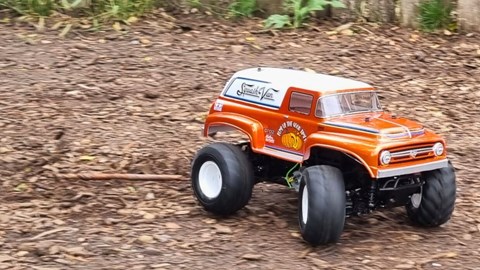
Tamiya manuals are amongst the best out there, clearly showing how parts go together. Hardware is shown life-size on the left margin for double checking and it’ll tell you where to grease. You might want to consider buying an extra tube of grease as there’s so many gears to lubricate.
My Squash Van isn’t quite standard out of the box. As with all my radio controlled cars, I’ve fitted a set of metal ball bearings instead of the solid metal and plastic bushes. The bearings allow the axles, gears and steering mechanism to run smoother, improving performance, durability and runtimes.
They’re cheap to buy and it makes sense to fit them now instead of having to strip everything in the future. The only snag is that they can rust if they get drenched and you don’t dry them. I’ve also selected a different main body colour – PS61 Tamiya metallic orange.
A speedy, but surprising build
One of the advantages of the unusual chassis layout is what felt like a build that progressed quickly. Your first steps are building the differentials and installing them, and all the idler gears that drive them, into the chassis.
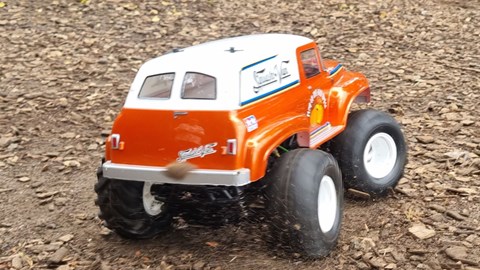
It’s at this point I realised the gear drive system was even more odd than I thought. Rather than the motor driving a single spur gear like most RC cars and trucks, the motor’s pinion gear drives the front and rear sets of gears separately. The twin spur gear arrangement means I’ll be keeping a close eye on the stock aluminium pinion. They wear out quickly spinning one gear, let alone two.
After applying a liberal amount of grease, I was soon closing up the chassis ready to add suspension at what felt like an early point in the build. The two-piece suspension arms slot together a specific way, with different arms front and rear. If I were building this with four-wheel steering, the front and rear suspension would be far more similar, but I’m keeping with two-wheel steer initially.
The springs fit over friction dampers that work best with a bit of grease in them and give good suspension travel. Front and rear bumpers look chunky, and both protect the body and hold the chassis sides together as well. Your electronics go in next with ample space on top of the chassis and clear cable routes that mean tidy wiring.
A splash of colour
As always for me, it’s the painting that’s the trickiest part. First, I wash and dry the inside of the body to help the paint stick, then cut out the masks for the windows. With those applied, I mask the roof before spraying the orange. Lots of thin coats are better than a few thick ones, and once the orange is dry, I peel off the roof masking and spray the shell white. Once dry, peel off the window masks and the clear protective film on the outside of the body.
As always with me, there is a little bit of paint bleed. Thankfully, Tamiya’s sticker sheet includes edging for these areas which hide my errors. The grille is the trickiest part to sticker, so use a hairdryer to get the stickers nice and flexible. All in all, everything fitted together well, and the build process was enjoyable.
The drive:
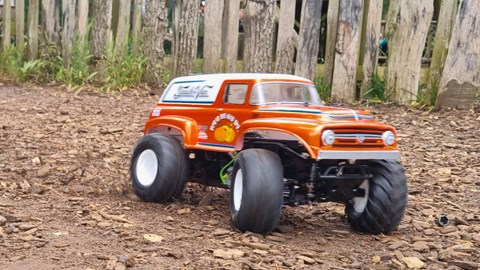
Tamiya kits are in many cases the first step into a hobby rather than toy-grade RC, so simplicity and durability have been prioritised over speed and tuning ability. Apart from the steering, all the suspension arms are non-adjustable, and there’s not a great deal you can do to tune the shocks.
With a standard Tamiya 27t ‘silver can’ 540-sized electric motor, the Squash Van has brisk acceleration at the expense of speed. Optional gearing can give it more top end, although the motor already gets roasting hot if you’re accelerating and braking hard a lot, and a bigger pinion will only make it worse. It’s much less of a problem when you’re driving gently or in more open environments, but I’ve still added an aftermarket motor heatsink to keep things cooler.
The included forwards, reverse and brake electronic speed controlled can run on either 7.2v NiMh packs or a 7.4v LiPo. It’s good fun on 7.2v and is the better bet for beginners. As I’ve been driving RCs for decades, a quick swap to a LiPo pack gives far more urgent acceleration and slightly more top speed.
After the initial 7.2v pack, all runs since have been carried out on 7.4v as it turns a fun truck into a real giggle. Even with two-wheel steering, there’s loads of lock which makes the Squash Van very manoeuvrable and surprisingly agile. It will roll if you launch it hard into a high grip corner, something that I’d expect from a tall truck.
Let’s off-road
While you can happily blast the Squash Van around on Tarmac, it’s off-road it really belongs. On some damp grass that one of my two-wheel drive trucks was really struggling with, the Squash Van had no issues romping around. Traction is good enough to climb a big dirt pile in my garden if you’ve got a little speed up, but this is no crawler out of the box.
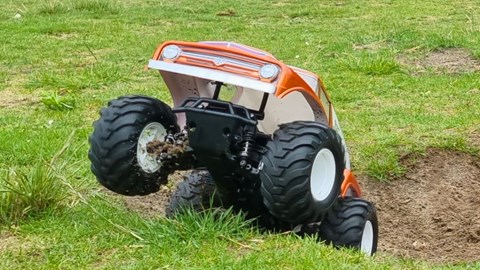
The open differentials that help it corner so tightly do limit its ability on properly treacherous stuff, but that’s the same for any truck like this. At least having built it, you’ll easily be able to lock the diffs if you do want to boost its extreme off-road capabilities.
Me? I was more interested in using it as intended, as a fun basher. The suspension is quite bouncy with those friction shocks, so really big jumps are out of the question. Keep things a little more sensible, and you can get decent airtime out of the box and land it pretty well, albeit with a bit of bounce if you send it a bit too hard.
It’s worth pointing out that the tyres are a hard compound with a classic Tamiya tread pattern. Alternative wheels and tyres are available and would boost grip, but I suspect it’ll just make it more prone to rolling over. Similarly, the rear-steer will only make it turn even tighter, increasing the chance of rolling.
That’s why the only future upgrade I’m strongly considering is a set of 60mm oil-filled shock absorbers to make it less bouncy on rough ground and when jumping. That said, a slightly quicker motor wouldn’t hurt…
Durability
The GF-02’s chassis and gears are almost entirely plastic, a good thing for those new to the hobby. Instead of metal that bends or composites that snap, the sturdy engineering plastic has a bit of flex, so it’ll bounce off most impacts.
I’ve so far run a number of packs through the car and not had a single issue that’s stopped me. I even handed it to a friend whose throttle-happy driving led to many altercations with fences, walls and other garden ornaments. While there is some scuffing on the body and bumper, the chassis took everything he could throw at it.
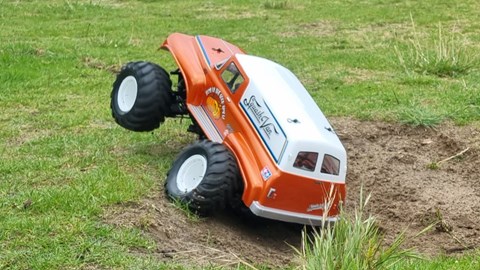
If you do manage to snap something, parts are readily available and not too expensive. That said, most major parts aren’t available as a single item, instead you buy the entire parts tree as it comes in the kit. It’s handy for having spare suspension arms and the like, but you do end up with plenty of items you’re unlikely to break.
Other things to look out for are the aluminium pinion which wears over time (look for teeth resembling saw blades). A steel replacement is cheap and will prevent this happening. Build without bearings and you’ll also find the axles and shafts will get wobbly over time as the bushes wear.
Any downsides?
Really, it’s just the stuff we’ve highlighted already. Friction shocks and no bearings is a bit stingy these days, and I’d advise against putting a crazy brushless system in there for more speed. It’s more top heavy than some rivals, and you won’t be pulling extreme stunts at the skatepark.
Price and competition:
The elephant in the room here is price. By the time you’ve got everything you need to get going, the Squash Van is as much if not more than faster rivals, albeit from less well-established manufacturers. Said rivals will often have better specs, with better shocks and bearings from day one.
These are predominantly ready to run offerings, though. Although it may seem strange to pay extra to put it together, it does allow you an extra level of personalisation. You’re also getting a shell that’s more detailed than rivals and parts availability that’s more reliable than some no-name RC you bought off AliExpress.
Verdict:

The Squash Van has proved to be a bit of a pleasant surprise. I had my doubts about the madcap gearing system and high-mounted battery, but it’s undeniably fun to drive. It’s quick enough on LiPo, runs well on a variety of surfaces, and you can jump it without having to worry too much about breaking it.
As for the build aspect, you’ll love it or hate it. No doubt kids will just want to get out and play, yet there’s a real joy to putting the kit together and understanding all the inner workings. It also makes it far easier to fix or upgrade further down the line.
It’s also worth pointing out that it looks much better than the usual generic monster trucks out there. Whether it’s on the shelf or running it looks great, and the size is perfect for me. It’s not too big to just chuck in the back of a car, but not so small it’s hard to find somewhere to run it.
To put it another way, I may have faster and more capable trucks in my collection, but it’s been the Squash Van that’s been run more than anything since it’s arrived.
4.5/5
Ratings:
Driving: 4.0
Building/maintaining: 5.0
Value for money: 3.0
Overall: 4.5
Specifications:
Size: 1/10th, length 454mm, width 280mm, height 238mm
Weight: 1760g (no battery)
Chassis material: Plastic
Power: 7.2v NiMh or 7.4v LiPo
Motor type: 540 brushed, 27T
Driven wheels: Four, gear drive
Top speed: 10-15mph
More items to consider:
Tamiya G6-01 Volvo A60G
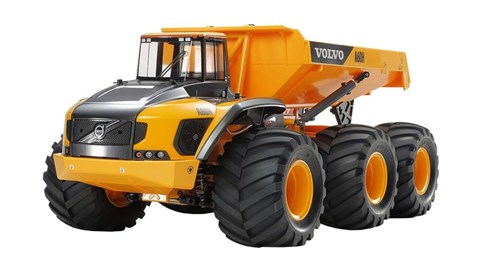
A six-wheel-drive alternative
Arrma Granite
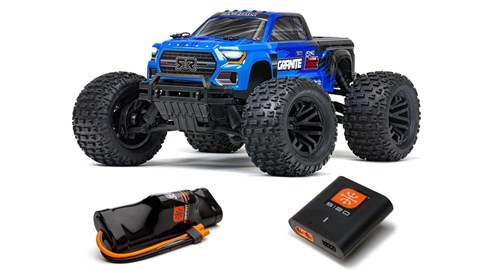
Ready to run and more capable out of the box
FTX Ramraider

Brushless power at a bargain price
Who tested the Tamiya GF-02 Squash Van?
Alan Taylor-Jones is the new cars editor for CAR magazine, and also Parkers. He’s been writing about cars professionally since 2015 but has been obsessed with them since not long after birth. When he’s not sampling the latest and sometimes greatest cars, he’s got his hands full with a young family and menagerie of pets. Even so, he still finds the time to have a play with RC cars and Hot Wheels.
How the Tamiya GF-02 Squash Van was tested?
We built the kit from scratch using Carson radio equipment and a 2100mah battery supplied by Tamiya UK. Once constructed, we drove it on a variety of surfaces including damp dirt, grass, concrete and Tarmac.
As the ESC is LiPo capable, we also took it for a blast on a suitable 2S pack to see what the performance difference was. We probably should have checked whether the Squash Van’s electronics were waterproof before aiming at a puddle, but it took it like a champ and kept running regardless.
Just so you know, whilst we may receive a commission or other compensation from the links on this website, we never allow this to influence product selections – read why you should trust us